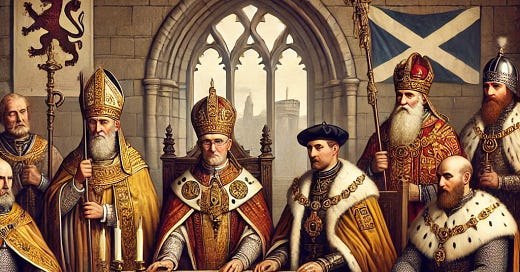Who Were The Guardians of Scotland?
The death of Alexander III in 1286 left Scotland in a precarious position. His passing ended a long period of relative stability and prosperity, plunging the nation into uncertainty. With no direct male heir and the throne promised to his granddaughter, Margaret, Maid of Norway, the kingdom required leadership to prevent chaos. To safeguard Scotland’s governance and protect its sovereignty during this critical period, six influential nobles were appointed as Guardians of Scotland. This blog delves into who the Guardians were, their roles, and the challenges they faced in a time of political upheaval.
Who Were the Guardians?
The Guardians of Scotland were selected by the Estates of Scotland (a council of nobles, clergy, and other influential figures) to act as regents in the absence of a monarch. Their task was to govern the realm in the name of Margaret, the Maid of Norway, who was only a child and living in Norway at the time. The Guardians were chosen for their political influence, military strength, and regional prominence. They represented a balance between competing factions within Scotland, aiming to maintain stability and unity. The original six Guardians were:
William Fraser, Bishop of St. Andrews – A prominent churchman with extensive political influence, Fraser played a key role in communicating with Edward I of England during the crisis.
Robert Wishart, Bishop of Glasgow – Known for his patriotism and later support of Scottish independence, Wishart represented the powerful clergy in the south.
Duncan, Earl of Fife – As a leader of one of Scotland’s oldest and most prestigious families, he brought noble legitimacy and a strong local power base.
Alexander Comyn, Earl of Buchan – A member of one of Scotland's most powerful noble families, Comyn added considerable weight to the Guardians’ collective authority.
James the High Steward of Scotland – The ancestor of the Stewart dynasty, his military and administrative capabilities were crucial in managing the kingdom’s resources.
John Comyn of Badenoch (the "Black Comyn") – Another influential member of the Comyn family, his inclusion ensured the representation of one of Scotland's most dominant political dynasties.
What Did the Guardians Do?
The Guardians were tasked with preserving the peace, administering justice, and safeguarding Scotland’s sovereignty until Margaret could assume the throne. This was no small feat, given the immense challenges they faced. Their primary responsibilities included:
1. Acting as Regents for the Crown
With no active monarch in the kingdom, the Guardians collectively represented royal authority. They issued decrees, collected taxes, and ensured the continuity of governance in Margaret’s name. Their decisions often required consensus, making their cooperation essential to prevent internal discord.
2. Managing External Diplomacy
The Guardians were deeply involved in diplomatic relations, particularly with England and Norway. They sent envoys to negotiate Margaret’s journey to Scotland and to maintain peace with Edward I of England, whose ambitions over Scotland were becoming increasingly apparent. Notably, they supported the Treaty of Salisbury in 1289, which outlined Margaret’s safe passage to Scotland.
3. Preserving Internal Stability
One of their most critical roles was to prevent infighting among Scotland’s powerful noble families. The Comyns, Bruces, Balliols, and other clans vied for influence, and the Guardians worked to maintain a fragile peace. Their ability to mediate disputes and enforce unity was vital to avoiding outright civil war.
4. Overseeing the Succession
The Guardians were instrumental in the formal recognition of Margaret as the rightful heir to the throne. They upheld the decisions made during the Estates of Scone, where Margaret was proclaimed successor to Alexander III, and ensured the nobility swore allegiance to her.
Challenges Faced by the Guardians
The Guardians’ task was far from easy, as they operated in an environment rife with political instability and external threats. Some of the key challenges they encountered included:
1. Divided Loyalties
The Guardians themselves were not a unified group. While they aimed to maintain stability, their personal allegiances to competing noble factions (such as the Bruces and Comyns) occasionally caused friction. These divisions weakened their collective authority and undermined their efforts to act decisively.
2. Edward I’s Interference
The English king, Edward I, took a keen interest in Scotland’s affairs during this period. While outwardly appearing as a mediator, Edward sought to assert influence over the kingdom. The Guardians had to navigate his growing demands, which included asserting his overlordship of Scotland—a claim that would later have devastating consequences.
3. Margaret’s Death
The Guardians’ plans for a stable succession were thrown into disarray when Margaret died unexpectedly in 1290. Her death triggered a full-blown succession crisis, as over a dozen claimants emerged to contest the throne. This event rendered the Guardians’ mission to install Margaret as queen moot and left Scotland vulnerable to external and internal strife.
4. The Rise of Rival Claimants
The Guardians faced the immediate challenge of managing powerful nobles like Robert Bruce and John Balliol, who began to maneuver for control of the throne. Their competing claims not only divided the nobility but also threatened to destabilize the country.
The Guardians’ Legacy
Although their tenure was short-lived, the Guardians of Scotland played a crucial role in maintaining the kingdom’s integrity during a critical period. They prevented immediate collapse following Alexander III’s death and ensured that Scotland remained a unified entity, even in the face of external threats and internal divisions.
However, their inability to establish a lasting solution to the succession crisis set the stage for decades of conflict. After Margaret’s death, Scotland entered a period of uncertainty that culminated in Edward I’s intervention and the eventual Wars of Scottish Independence. Despite this, the efforts of the Guardians to preserve Scotland’s sovereignty during such a turbulent time remain an important chapter in the country’s history.





